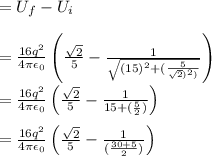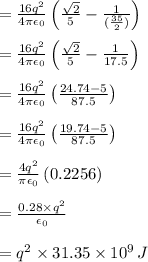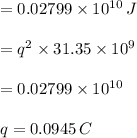
NASA has asked your team of rocket scientists about the feasibility of a new satellite launcher that will save rocket fuel. NASA's idea is basicallyan electric slingshot that consists of 4 electrodes arranged in a horizontal square with sides of length d at a height h above the ground. The satellite is then placed on the ground aligned with the center of the square. A power supply will provide each of the four electrodes with a charge of Q/4 and the satellite with a charge -Q. When the satellite is released from rest, it moves up and passes through the center of the square. At the instant it reaches the square's center, the power supply is turned offand the electrodes are grounded, giving them a zero electric charge. To test this idea, you decide to use energy considerations to calculate how big Q will have to be to get a 100 kg satellite to a sufficient orbit height. Assume that the satellite startsfrom 15 meters below the square of electrodes and that the sides of the square are each 5 meters. In your physics text you find the mass of the Earth to be 6.0 x 1024kg.

Answers: 2


Another question on Physics

Physics, 22.06.2019 12:10
Consider a one meter long horizontal pipe with a constant 100 cm^2 cross sectional area. water flows rightward into the pipe at x = 0 with flow velocity 02m/sec at every point within the pipe intake area. at x=1, the rightward flow rate is 0.192 m/sec. assume the water is a conserved quantity in the pipe, so there must be a leak (a sink) somewhere in the pipe. 1. compute net volumetric flow of the source if the system to be in equilibrium. 2. now assume the pipe in the problem has no leaks. compute the net volumetric rate of change for the system.
Answers: 3

Physics, 22.06.2019 16:40
Aparticle's position is given by x = 3.00 - 9.00t + 3t2, in which x is in meters and t is in seconds. (a) what is its velocity at t = 1 s? (b) is it moving in the positive or negative direction of x just then? (c) what is its speed just then? (d) is the speed increasing or decreasing just then? (try answering the next two questions without further calculation.) (e) is there ever an instant when the velocity is zero? if so, give the time t; if not, answer "0". (f) is there a time after t = 3 s when the particle is moving in the negative direction of x? if so, give the time t; if not, answer "0".
Answers: 3

Physics, 22.06.2019 17:50
Convection occurs when thermal energy is transferred by the movement of
Answers: 1

Physics, 22.06.2019 21:00
The first law of thermodynamics states that heat added to a system is neither created nor destroyed but is as it changes into other forms of energy.
Answers: 1
You know the right answer?
NASA has asked your team of rocket scientists about the feasibility of a new satellite launcher that...
Questions












Computers and Technology, 20.08.2019 05:20



Social Studies, 20.08.2019 05:20



Geography, 20.08.2019 05:20


Biology, 20.08.2019 05:20

 ".
".








